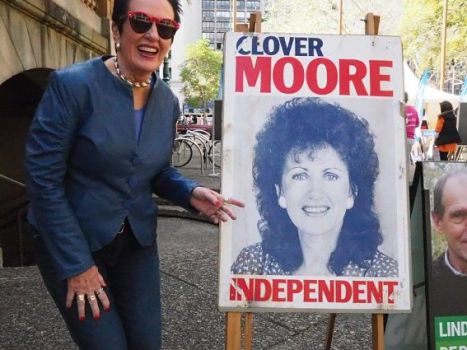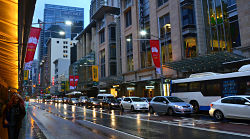By Julian Bajkowski
City of Sydney Lord Mayor Clover Moore has upped pressure on the New South Wales state government to extend a planned pedestrian zone in the heart of the central business district and shopping strip as part of existing plans to roll out a new $1.6 billion light rail run connecting the city and the Eastern suburbs.
Ms Moore on Thursday launched a fresh publicity offensive at Premier Barry O’Farrell aimed at increasing popular pressure for enlarging present plans for car-free mall on George Street after she revealed detailed plans and models of how the extended promenade would look, replete with new trees.
While Mr O’Farrell and his Transport Minister Gladys Berejiklian have so far committed to creating a pedestrian and light rail precinct between Bathurst Street and Hunter Street in the CBD, the plans that the City of Sydney has put on public exhibition extend that zone to Bridge Street headed north and Liverpool Street headed south – or cumulatively between three and five city blocks depending on the side of the road.
The exhibition is located at Customs House in Circular Quay and runs from 4th April 2013 to 3rd May 2013 from 8am until midnight on weeknights with marginally shorter hours on the weekend and the council has put photos of its proposal online.
The City of Sydney has called for submissions on its 'Draft George Street Concept Design' in writing by 6pm on Friday3rd May 2013.
The extent of O’Farrell government’s commitment to extending light rail in the city and to the east following its election two years ago was a substantial win for the City of Sydney after the CBD and surrounds became increasingly gridlocked under the previous Labor government’s appetite for new tunnels, toll roads and motorway extensions.
While Ms Moore has been a trenchant critic of state government traffic management plans that increase car traffic to the CBD, Transport Minister Gladys Berejiklian has remained key proponent of the light rail solution after she secured the backing of the Premier to prevail over rival plans to create a massive underground bus interchange.
The chronic congestion of busses in the Sydney CBD has become a hot-button issue for millions of commuters because it can often take as long or longer to travel through the city than it does to get there from the suburbs – even with dedicated bus lanes.
Sydney’s new light rail extension aims to be the circuit breaker in solving overground traffic jams because it will be able to transfer passengers to higher capacity vehicles that have their own run.
Importantly, the City of Sydney is financially contributing $220 million to the new light rail rollout, money that effectively buys it a far bigger say in negotiations with the state government.
A seasoned political and media campaigner, Ms Moore has seized on the light rail rollout as a catalyst for transforming the CBD into an area that is designed around people rather than cars – essentially by increasing the amount of road redesignated as non-car areas.
Entitled “Next stop: 21st century George Street” Ms Moore’s latest exhibition visually showcases what “25,000 square metres of roadway turned into a huge, tree-lined pedestrian boulevard” would look like rather than having people try and imagine it.
“Light rail gives us a chance to revitalise the entire city centre, not just transforming George Street but also the laneways that run off it, making the city an exciting place to explore,” Ms Moore said.
“At the moment, George Street is choked by day and drab at night. This exhibition shows we can make it a wonderful wide boulevard where people will want to walk, shop, dine and meet up with friends.”
To ram the point home, Sydney’s Lord Mayor has enlisted the heavy hitters of the retail, business and tourism lobbies to help pressure the O’Farrell government from the inside as well as the outside.
Many businesses in central Sydney are cheering on interventionist plans to revatalise the CBD and its fringes to attract more people to stay and shop as they face subdued consumer sentiment combines with restrained inbound tourism spending because of the high Australian dollar.
The head of the Australian National Retailers Association, Margy Osmond, lent her support to Ms Moore and said her members were “very excited about the prospect of a much more glamorous George Street which will be a magnet for local shoppers and our visiting tourists” – in a statement released by Ms Moore.
The chairman of the highly influential Tourism and Transport Forum, Bruce Baird, praised the new CBD plans for their potential to “transform George Street from a fume-filled, congested and noisy road into a pedestrian-friendly retail boulevard befitting Sydney’s status as a global city.”
As the lobbying, arm-twisting and public relations battle continues, the City of Sydney and the state government are aiming to have “a development agreement defining how much of George Street will be reserved for pedestrians only” by August.
“The City and the State have approved a Memorandum of Understanding that includes the City’s interest in expanding the pedestrian area from Liverpool to Bridge Streets along George Street and we remain optimistic that both pedestrian and traffic benefits would be enhanced by slightly extending the pedestrian area to the north and south,” Ms Moore’s office said in a statement.
Comment below to have your say on this story.
If you have a news story or tip-off, get in touch at editorial@governmentnews.com.au.
Sign up to the Government News newsletter



Definition if pedestrianised: only open to pedestrians. The george st project will see a high service tram service run through it so the middle portion of the street will still not be for pedestrians. I believe it is an abdurd project in those regards. I say yes to pedestrianisation, NO to light rail. If sydney was to be 21st century, there would be an underground metro underneath george st.
Michael has obviously never been to Europe where pedestrians and light rail co exist in major cities on a most harmonious basis. Perhaps he is suggesting that Sydney pedestrians possess some cognitive deficiency that renders them unable to detect the approach of a tram .